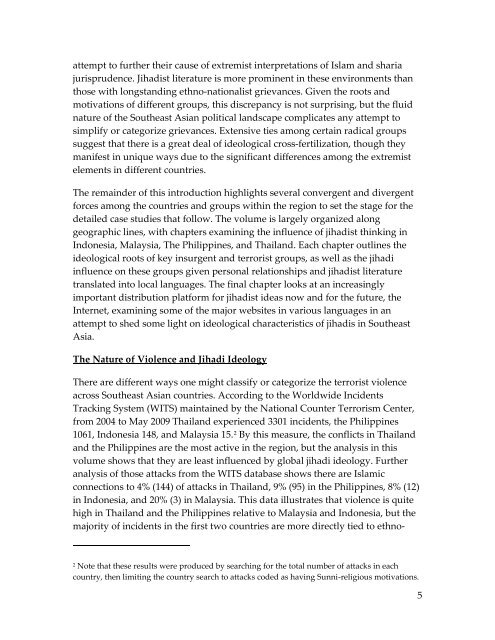Create successful ePaper yourself
Turn your PDF publications into a flip-book with our unique Google optimized e-Paper software.
attempt to further their cause of extremist interpretations of Islam and sharia<br />
jurisprudence. Jihadist literature is more prominent in these environments than<br />
those with longstanding ethno-nationalist grievances. Given the roots and<br />
motivations of different groups, this discrepancy is not surprising, but the fluid<br />
nature of the Southeast Asian political landscape complicates any attempt to<br />
simplify or categorize grievances. Extensive ties among certain radical groups<br />
suggest that there is a great deal of ideological cross-fertilization, though they<br />
manifest in unique ways due to the significant differences among the extremist<br />
elements in different countries.<br />
The remainder of this introduction highlights several convergent and divergent<br />
forces among the countries and groups within the region to set the stage for the<br />
detailed case studies that follow. The volume is largely organized along<br />
geographic lines, with chapters examining the influence of jihadist thinking in<br />
Indonesia, Malaysia, The Philippines, and Thailand. Each chapter outlines the<br />
ideological roots of key insurgent and terrorist groups, as well as the jihadi<br />
influence on these groups given personal relationships and jihadist literature<br />
translated into local languages. The final chapter looks at an increasingly<br />
important distribution platform for jihadist ideas now and for the future, the<br />
Internet, examining some of the major websites in various languages in an<br />
attempt to shed some light on ideological characteristics of jihadis in Southeast<br />
Asia.<br />
The Nature of Violence and Jihadi Ideology<br />
There are different ways one might classify or categorize the terrorist violence<br />
across Southeast Asian countries. According to the Worldwide Incidents<br />
Tracking System (WITS) maintained by the National Counter Terrorism Center,<br />
from 2004 to May 2009 Thailand experienced 3301 incidents, the Philippines<br />
2<br />
1061, Indonesia 148, and Malaysia 15. By this measure, the conflicts in Thailand<br />
and the Philippines are the most active in the region, but the analysis in this<br />
volume shows that they are least influenced by global jihadi ideology. Further<br />
analysis of those attacks from the WITS database shows there are Islamic<br />
connections to 4% (144) of attacks in Thailand, 9% (95) in the Philippines, 8% (12)<br />
in Indonesia, and 20% (3) in Malaysia. This data illustrates that violence is quite<br />
high in Thailand and the Philippines relative to Malaysia and Indonesia, but the<br />
majority of incidents in the first two countries are more directly tied to ethno-<br />
2<br />
Note that these results were produced by searching for the total number of attacks in each<br />
country, then limiting the country search to attacks coded as having Sunni-religious motivations.<br />
5


